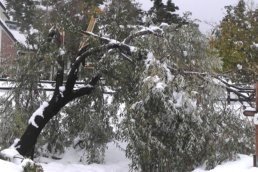
Heavy fall snow pushed this tree over.
When we’re still hovering around the 90-degree range, it’s hard to think about the chilly days of winter when snow and winds ravage our plants. But now is the time to get plants in shape before the storms of winter.
Late summer pruning is very good for deciduous trees and shrubs. You can remove unneeded foliage that can overload with snow and break branches when those early snowstorms come before the leaves have dropped. This is exactly what happened in the fall of 2014 when countless plants were devastated.
For pruning larger trees, it’s wise to hire a pro who has the equipment and gear to scurry up the tree safely and do the work correctly.
There really are rules about how tree branches should be cut to preserve the health of the tree. And, there are also best practices about how to thin a tree to avoid winter snow overloads.
Plus, a tree pro can deal with the debris so it is disposed of properly by turning it into mulch or compost. That is another time-saver for homeowners.
What can you prune in the fall?
Basically most shrubs and deciduous trees that need to be lightened to avoid early storm damage or that have overgrown the available space.
Are there plants you shouldn’t prune now?
- Spring-flowering trees such as stone fruits – crabapple, apple, peaches, etc.
- Spring flower shrubs such as lilac, potentilla and forsythia
All of these spring bloomers set their buds that will be next spring’s fruits and flowers in this growing season. If you prune them now, you will lose those spring blooms and next year’s fruits.
Wait until next spring to prune flowering plants after they have bloomed.
Courtesy of ALCC Sustainable Landscape Partners
